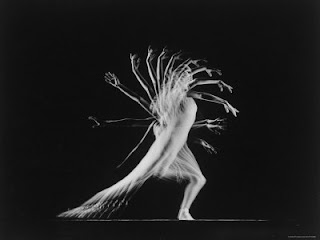46) Illusion of Motion by Multiple Image
There are multiple images taken and overlapping in a manner that shows motion.
45) Illusion of Motion by Blurred Outline
The blur around the dog shows that it is running very fast.
44) Illusion of Motion by Repeated Figure
These repeated figures show motion because they start off walking and then begin to run and jump.
43) Anticipated Motion
This painting shows the the bike is moving and the guy is riding it.
41) Multiple Perspective
This has many different visual perspectives. The image shows the face at a side view with the body parts on the side of her face.
40) Amplified Perspective
This adds a dramatic, dynamic touch to the image. It is pointed directly at the viewer.
39) Illusion of Space by Linear Perspective
Linear perspective is a mathematical system for projecting the apparent
dimensions of a
sculptural object onto a flat surface.
38) Illusion of Space by Aerial Perspective
37) Illusion of Space by Vertical Location
This is a good example because the road is vertical and continues to get smaller showing that it goes on for a long time.
36) Illusion of Space by Overlapping
35) Scale Confusion
In this image he is closer to the camera making the tower look smaller. The scale confusion makes it look as if his foot is actually on the side of it.
34) Alternating Rhythm
This is when to or more objects are alternated in different ways.
33) Progressive Rhythm
A repeated shape changing in color, size, or texture.
32) Absence of Focal Point
Images with this do not have focal point in them. If it's a pattern with a theme it doesn't need a focal point.
31) Degree of Emphasis
There are many points of visual interest that catches your eye.
30) Emphasis by Placement
The object that is placed in the center is usually known as the focal point.
29) Emphasis by Isolation
This is when most of the objects are grouped together and one object stands out by itself as the focal point.
28) Emphasis by Contrast
With emphasis by contrast certain parts of the image will stand out more than others. It will have a specific focal point.
27) Crystallographic Balance
An image with
equal emphasis over the entire area is called Crystallographic Balance.
26) Radial Balance
All elements
in the image radiate out from a center point in a circular fashion.
25) Asymmetrical Balance
Asymmetrical design is usually off-centered. It doesn't have perfect symmetry.
24) Symmetrical Balance
A vertical axis is required to achieve balance with symmetry. Symmetrical balance is also called formal balance because a form is used -- a mirror image about a vertical axis.
23) Unity with Variety
Unity is the appearance or condition of oneness. Variety provides diversity.
22) Unity through Continuity
Continuity is the visual relationship between two or more individual designs. Many artists use grids to show continuity.
21) Unity through Continuation

In this painting your eyes continue to look down the repeating columns. Thats where the continuation comes in.
20) Unity through Repetition

This is a good example because all of the circles are creating a pattern. THe white paint being placed in different spots inside of the circles just gives it a better feel.
19) Unity through Proximity
17) Tactile Texture

Many different surfaces are good examples of tactile texture. You can almost feel it just by looking at it.
16) Value as Emphasis

This is a good example because there is emphasis on the pathway going through the flowers. The bright white stands out from the rest of the painting giving it emphasis.
15) Value as Pattern

This is an example because there are many different colors lined up like puzzle pieces in a pattern.
14) Curvilinear Shapes

This is a good example because all of the lines in the painting are curved giving the painting more depth. The entire painting is curved.
13) Rectilinear Shapes

The lines in this painting are parallel to the horizontal and vertical lines. This makes it rectilinear.
12) Nonobjective Shapes

This is a good example because there is nor reference to the natural world. It's just random brush strokes of different colors.
11) Abstraction

This is an example of abstraction because there is no real meaning behind it. It's just a bunch of random splatters of paint mixed together.
9) Distortion

This is such a good painting of distortion because his face is so unproportional and disoriented. Also the distortion of his nck shows that he has large muscles.
8) Naturalism

This painting is so realistic, that's why it is such a good example of naturalism. When someone pictures a lion, this is exactly how they would see it.
7) Lost and Found Contour

In this painting you can't see his beard because it blends into the black but it is still there. As well as parts of his face.
5) Gesture Line

This painting is a good example because you can tell that the woman is shaking her head. The lines and different colors of the hair shows the movement.
4) Contour Line

This is an example of countour line because the lines are distincitive and show that it's a baby's head.
3) Line as Emotion

This painting shows happiness, confusion, and chaos. All of the bright colors show happiness. The colors overlapping and looking like they were splattered on shows chaos and confusion.
2) Line Direction

In this painting the horizontal and vertical black lines separate the colored squares and make them stick out from the white ones. The random colors give a good vibe to the painting and the black lines just add to it.
1) Line as Shape
L

ine by shape is used in this coloring page portrait because the lines show that the drawing is a person.




































0 comments: